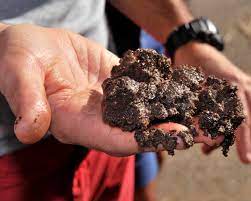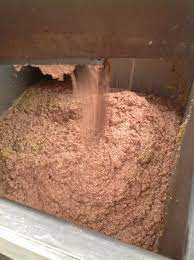Olive pulp, also known as olive pomace, is a byproduct of the olive oil production process. It is the residue left after olives are crushed and pressed to extract the oil. Olive pulp consists of crushed olive skins, seeds, and some residual oil. Olive pulp is composed mainly of the following components:
Olive pulp typically has a coarse, pulpy texture with a mix of solid olive fragments, crushed seeds, and skins. It can vary in color from dark brown to black, depending on the olive variety and processing method. The odor of olive pulp can be characteristic of olives, albeit more intense due to the concentrated components. The flavor is bitter and astringent, with some residual olive oil taste.
Proper disposal or utilization of olive pulp is crucial to minimize environmental impact. If not managed appropriately, olive pulp can contribute to environmental pollution due to its high organic load.
Some environmentally conscious olive oil producers focus on sustainable practices, finding innovative ways to utilize olive pulp efficiently, such as converting it into useful products like biofuels or incorporating it into circular economy models.
The Economic Importance and Uses of Olive Pulp

Olive pulp, a byproduct of olive oil production, has several economic uses and benefits across various industries.
Here are the economic importance and uses of olive pulp:
1. Animal Feed and Nutrition: Olive pulp is rich in fiber and nutrients, making it a valuable ingredient in animal feed. It can be used to supplement livestock and poultry diets, providing essential nutrients and improving overall animal health.
2. Biogas Production: Olive pulp can be used as a feedstock for biogas production through anaerobic digestion. This process converts organic matter into biogas (methane and carbon dioxide), which can be used for energy generation, providing a sustainable and renewable energy source.
3. Compost and Soil Amendment: Olive pulp can be composted and used as an organic soil amendment. Its organic matter enriches the soil, improves its structure, enhances water retention, and provides essential nutrients to plants, promoting healthy crop growth and higher agricultural yields.
4. Bioethanol Production: Olive pulp can serve as a feedstock for bioethanol production. Through fermentation and distillation processes, the sugars present in the pulp can be converted into ethanol, a biofuel that can be blended with gasoline or used independently as an alternative fuel source.
5. Pharmaceutical and Cosmetics Industry: Olive pulp contains bioactive compounds and antioxidants such as polyphenols, which have potential applications in the pharmaceutical and cosmetics industries. Extracts from olive pulp may be used in the production of dietary supplements, skincare products, and pharmaceutical formulations due to their potential health benefits.
6. Fertilizer Production: Olive pulp can be processed to extract valuable nutrients and minerals, which can be used to manufacture organic fertilizers. These fertilizers can enhance soil fertility, promote plant growth, and contribute to sustainable agricultural practices.
7. Food Industry: While olive pulp is a byproduct of olive oil production, some food products can be derived from it. It can be used to produce dietary fibers, fillers for baked goods, and other food additives. Additionally, olive pulp can be processed to extract oil and incorporate it into various food products.
Read Also: Olive Leaves: Economic Importance, Uses, and By-Products
8. Water Purification and Wastewater Treatment: Olive pulp can be utilized in water treatment processes to absorb pollutants and heavy metals from industrial wastewater. Its high organic content makes it an effective adsorbent, aiding in the purification of water and reducing environmental pollution.
9. Environmental Sustainability and Waste Reduction: Utilizing olive pulp in various applications helps reduce waste generated from olive oil production, promoting sustainable and eco-friendly practices. By finding economic uses for this byproduct, the environmental impact of olive oil production is minimized.
The Products and By-products That Can Be Derived From Olive Pulp
Olive pulp is a byproduct of olive oil production and consists of the remaining solids after the extraction of olive oil. While olive oil is the primary product obtained from olives, olive pulp can be utilized to create various other products and by-products.
Here’s a list and explanation of some products and by-products that can be derived from olive pulp:
1. Olive Pomace Oil: Olive pomace oil is extracted from the remaining olive pulp using solvents and mechanical processes. It is of lower quality compared to extra virgin or virgin olive oil and is typically used for cooking and industrial applications.
2. Olive Pomace Cake: After oil extraction from the olive pulp, the residual solid material is known as olive pomace cake. It can be further processed to create various products.
3. Olive Pomace Pellets: Olive pomace cake can be dried and compressed to create pellets. These pellets can be used as a biomass fuel for heating or as a supplement in animal feed.
Read Also: Cassava Petioles: Economic Importance, Uses and By-Products
4. Olive Pomace Meal: Olive pomace cake can also be ground into a finer meal-like consistency, which can be used as a nutritional supplement in animal feed due to its fiber and nutrient content.
5. Olive Pomace Extracts: Various bioactive compounds, such as phenolic compounds and antioxidants, can be extracted from olive pomace. These extracts have potential applications in the food, cosmetic, and pharmaceutical industries.
6. Biogas and Bioenergy: Olive pulp can be utilized in anaerobic digestion processes to produce biogas, a renewable source of energy. The biogas can be used for electricity generation or as a heat source.
7. Compost and Organic Fertilizer: Olive pulp can be composted to produce organic fertilizer. Its nutrient-rich composition makes it a valuable soil conditioner and fertilizer for agricultural use.
8. Animal Bedding: Dried olive pomace can be used as animal bedding due to its absorbent properties. It provides a comfortable and hygienic bedding material for livestock.
9. Olive Pomace Silage: Olive pulp can be ensiled and used as feed for livestock, providing supplementary nutrition to animals.
10. Lignocellulosic Material: Olive pulp contains lignocellulosic material, which can be further processed to produce materials like fiberboards, paper, and other bio-based products.
11. Food Ingredients: Olive pulp can be used as a source of dietary fiber and other bioactive compounds for incorporation into food products, such as functional foods and dietary supplements.
12. Biochar: Olive pulp can be pyrolyzed to produce biochar, a carbon-rich material used to improve soil structure, retain moisture, and enhance nutrient availability in agricultural soils.
In conclusion, olive pulp has economic importance across multiple industries, including agriculture, energy, pharmaceuticals, cosmetics, food, and environmental sustainability. Its utilization in various applications contributes to resource efficiency, waste reduction, and the development of sustainable practices.
Read Also: Comprehensive Farm Startup Guide

